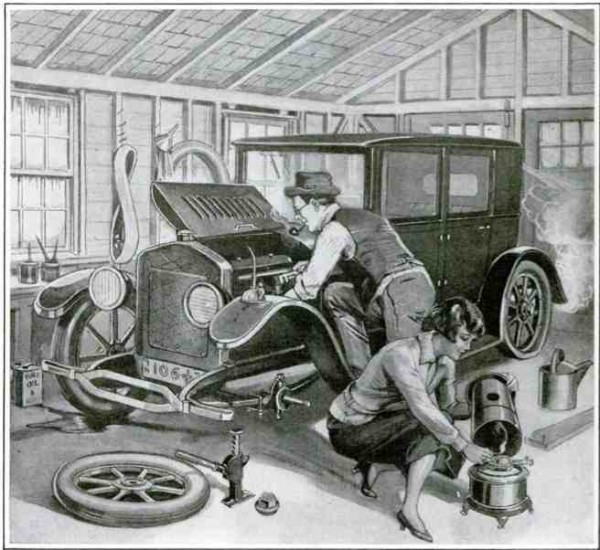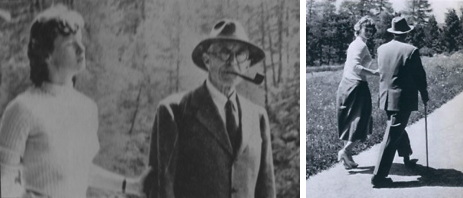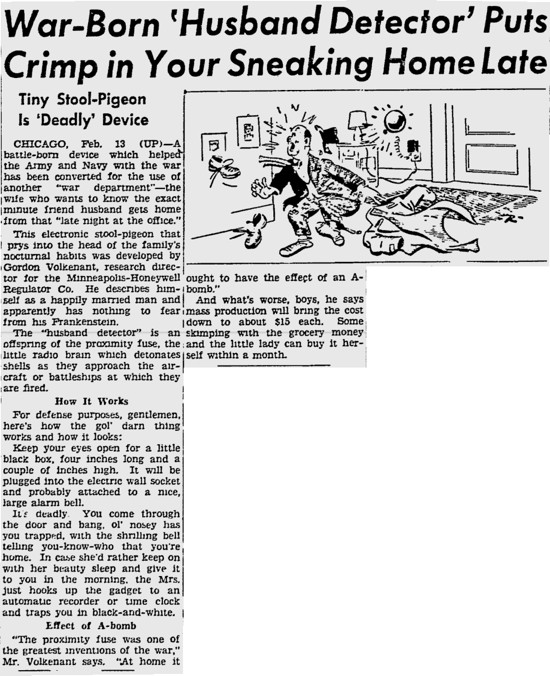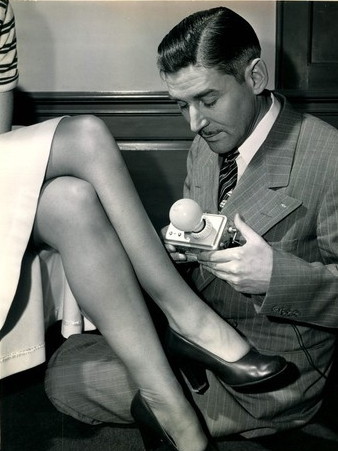Husbands
John and Mary Newlywed

In 1925 and 1926, Popular Science featured the antics of "John and Mary Newlywed," a young married couple so stupid they did everything wrong around the house. In the instance above from March 1926, John and Mary--despite having perfected anti-gravity as attested to by the unsupported car--are about to blow themselves up and smother themselves with gas fumes.
I regret the Newlyweds did not have a longer run. They would have been the Gallant-less Goofuses of the hobbyist set.
Posted By: Paul - Thu Sep 11, 2014 -
Comments (20)
Category: Husbands, Wives, 1920s, Goofs and Screw-ups
Father’s Day Greetings

Posted By: Paul - Sun Jun 15, 2014 -
Comments (7)
Category: Holidays, Husbands, Parents
Tightrope Wedding
Posted By: Paul - Sun Jun 08, 2014 -
Comments (2)
Category: Daredevils, Stuntpeople and Thrillseekers, Husbands, Wives, 1950s, Europe
Are You Ready for Marriage?
Posted By: Paul - Fri May 09, 2014 -
Comments (3)
Category: PSA’s, Sexuality, Husbands, Teenagers, Wives, 1950s
Marital Bliss
These two sound like they were a happy couple.
UNIONTOWN, FEB. 25 -- Because she kept her fingers crossed during her marriage ceremony, Mrs. Mary Frances Wilson of Connellsville, told her husband that she had a right to break her marriage vows, according to testimony given by Davis Wilson, a P. and L.E. railroad conductor, who formerly resided at Newell, but who now lives at Uniontown. The husband, who was granted a divorce, said that when he objected to his wife's conduct she gave him the "crossed finger" alibi. Wilson declared that his wife's goodbye each morning when he left home for work was to hope that he would be ground to pieces before the day's work ended. The husband declared that he became so worried over his wife's actions that he cut his own throat and for a time lingered between life and death. He recovered weeks later and since that time he and his wife were estranged.
Indiana Evening Gazette - Feb 25, 1930
Posted By: Alex - Thu Feb 20, 2014 -
Comments (5)
Category: Husbands, Wives, 1930s
Conjugal Duels
From Charles Harper, Revolted Woman: Past, Present, and to Come (1894):
The images of the conjugal duelists come from Hans Talhoffer's Fechtbuch, 1467 (plates 242-250). [Via Wondermark]
Posted By: Alex - Mon Nov 04, 2013 -
Comments (7)
Category: History, Husbands, Wives, Marriage
Briefly Married
Could this have been the shortest marriage ever? And does this kind of thing (dropping dead at the altar) happen often enough that it's no longer weird? [Source: The Day - Apr 3, 1967]
Posted By: Alex - Thu May 09, 2013 -
Comments (4)
Category: Death, Husbands, 1960s
A May-December Romance
Back in 1955, it caused some controversy when Count William Aubrey Tealdi married Princess Lidia Maria Antonia Carraciolo di Torella, the reason being that he was 74 and she was 14. They had to get a special papal dispensation to allow the marriage. Predictably, he was rich, while her family (though Italian royalty) had fallen on hard times. [google news]
But the strange thing is that despite the huge difference in age, the marriage proved to be a success. A follow-up story that ran in papers in 1966, when she was 25 and he was 85, reported that the couple had three children by that time, and he was hoping to have more. She declared herself to be "the happiest woman in the world."

I don't know when Count Tealdi died, but it's quite likely she's still alive. After all, she'd only be in her early seventies — not yet the age the Count was when he married her!
Posted By: Alex - Mon Mar 18, 2013 -
Comments (8)
Category: Elderly, Husbands, Wives, 1950s
Harmless
"The story is about a husband and father and his battle with pornography. Actual home movies and interviews tell the story of the terror the family faces when a box of pornography is opened and something is unleashed."
Backed by a religious group. Surprised?
And if you haven't guessed, despite the subject matter, it's Safe For Virginal Eyes.
Posted By: Paul - Sat May 05, 2012 -
Comments (10)
Category: Family, Husbands, Ineptness, Crudity, Talentlessness, Kitsch, and Bad Art, Movies, PSA’s, Sexuality, Genitals, Mental Health and Insanity
The Husband Detector
Dr. Gordon Volkenant seems like he was quite the character. In 1947, he invented a gadget he called the "husband detector." It was basically a motion detector, designed to help wives catch their husbands who were trying to sneak unheard into the house after a late night at the bar. When it sensed someone coming through the door, it set off a loud siren. link: Pittsburgh Press
Volkenant promptly became the first husband to be caught by his own device, when it rang the alarm as he tried to sneak into his house at 3 a.m. link: Washington Reporter
And based on the look of him, I'm guessing he wasn't just at the bar until 3 a.m. Here he is in 1948 demonstrating another of his gadgets, which he called an "electronic humidistat." He claimed it could detect hosiery defects in nylon stockings when he waved it up and down a woman's leg. It looks a lot like a regular lightbulb to me. I'm sure he found it necessary to test on many women.

Posted By: Alex - Wed Apr 25, 2012 -
Comments (7)
Category: Inventions, Lies, Dishonesty and Cheating, Husbands

| Who We Are |
|---|
| Alex Boese Alex is the creator and curator of the Museum of Hoaxes. He's also the author of various weird, non-fiction, science-themed books such as Elephants on Acid and Psychedelic Apes. Paul Di Filippo Paul has been paid to put weird ideas into fictional form for over thirty years, in his career as a noted science fiction writer. He has recently begun blogging on many curious topics with three fellow writers at The Inferior 4+1. Contact Us |




